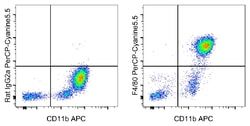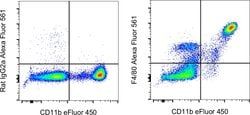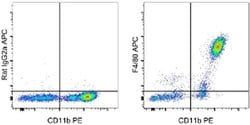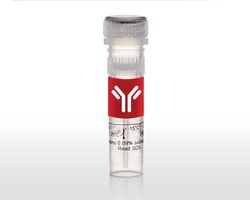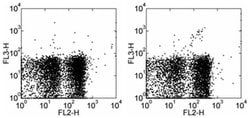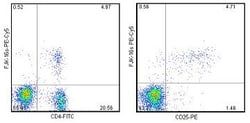F4/80 Monoclonal Antibody (BM8), PE-Cyanine5, eBioscience™, Invitrogen™
Rat Monoclonal Antibody
Manufacturer: Fischer Scientific
The price for this product is unavailable. Please request a quote
Antigen
F4/80
Concentration
0.2 mg/mL
Classification
Monoclonal
Form
Liquid
Regulatory Status
RUO
Formulation
PBS with 0.09% sodium azide; pH 7.2
Gene Alias
ADGRE1; Adhesion G protein-coupled receptor E1; Adhesion G protein-coupled receptor E2; cell surface glycoprotein EMR1; cell surface glycoprotein F4/80; DD7A5-7; EGF-like module containing, mucin-like, hormone receptor-like 1; EGF-like module containing, mucin-like, hormone receptor-like sequence 1; EGF-like module receptor 1; EGF-like module-containing mucin-like hormone receptor-like 1; EGF-TM7; Emr1; EMR1 hormone receptor; F4/80; Gpf480; Ly71; lymphocyte antigen 71; TM7LN3
Gene Symbols
ADGRE1
Primary or Secondary
Primary
Content And Storage
4° C, store in dark, DO NOT FREEZE!
Gene
ADGRE1
Clone
BM8
Applications
Flow Cytometry
Conjugate
PE-Cyanine5
Host Species
Rat
Target Species
Mouse
Gene Accession No.
Q61549
Gene ID (Entrez)
13733
Isotype
IgG2a κ
Purification Method
Affinity chromatography
Product Type
Antibody
Description
- Description: The BM8 monoclonal antibody reacts with mouse F4/80 antigen, an approximately 160 kDa surface receptor
- It belongs to the EGF-TM7 family of proteins
- As such it contains seven EGF-like domains on its extracellular N-terminus, seven transmembrane spanning sequences, and an intracellular C-terminal domain showing homology to other TM7 superfamily members
- The F4/80 antigen is expressed by a majority of mature macrophages and is one of the best markers for this population of cells
- However, other cell types, such as peritoneal eosinophils, Langerhans cells, and some other dendritic cell subtypes, have been reported to express this antigen as well
- Expression of F4/80 commences during early myeloid development in vivo and can be upregulated on BM cells stimulated in vitro with M-CSF
- Some populations of macrophages, especially in the lymphoid microenvironment, may be devoid of F4/80
- Applications Reported: The BM8 antibody has been reported for use in flow cytometric analysis
- Applications Tested: The BM8 antibody has been tested by flow cytometric analysis of mouse resident peritoneal exudate cells
- This can be used at less than or equal to 0.25 μg per test
- A test is defined as the amount (μg) of antibody that will stain a cell sample in a final volume of 100 μL
- Cell number should be determined empirically but can range from 10^5 to 10^8 cells/test
- F4/80 antigen is a 160 kDa cell surface glycoprotein that is a member of the EGF TM7 family of proteins and shares 68% overall amino acid identity with human EGF module containing mucin like hormone receptor 1 (EMR1)
- Expression of F4/80 is heterogeneous and is reported to vary during macrophage maturation and activation
- The F4/80 antigen is expressed on a wide range of mature tissue macrophages including Kupffer cells, Langerhans, microglia, macrophages located in the gut lamina propria, peritoneal cavity, lung, thymus, bone marrow stroma and macrophages in the red pulp of the spleen
- F4/80 expression has also been reported on a subpopulation of dendritic cells but is absent from macrophages located in T cell areas of the spleen and lymph node
- The ligands and biological functions of the F4/80 antigen have not yet been determined but recent studies suggest a role for F4/80 in the generation of efferent CD8+ve regulatory T cells.
